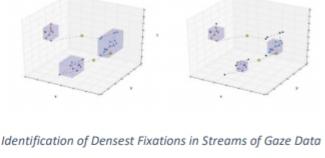Fixation Identification Using Density Optimization
Eye tracking technologies are becoming more advanced, cheaper, and more likely implemented into the designs of laptop computers. With this growth of technology, an opportunity rises to greater understand how people process information and make decisions. The analysis of gaze data collected by eye tracking devices can enable professionals in fields such as education and training or psychiatry to develop strategies to mitigate excessive cognitive load for a person.
An algorithm that analyzes the densest fixations in streams of gaze data to make conclusions on the cognitive efforts of a user has been developed at Worcester Polytechnic Institute (WPI). Since the algorithm, unlike previous methods, focuses on densest fixations, outlier gaze points are eliminated that otherwise skew fixation metrics. When embedded in a decision support system (DSS) that includes a remote infrared eye tracking device that can monitor a user’s eye movement, this algorithm transforms the DSS into an adaptive system that can utilize the user’s density of fixation information to assess the cognitive burden a user endured, serving as an invaluable tool in personalizing decision support training for a user, or making accurate and reliable cognitive diagnoses.

Key Features/Benefits
- Remote Infrared Eye Tracking Device
- Algorithm to identify densest fixation in gaze data for cognitive load analysis
- Elimination of outlier gaze points in fixation metrics
- Runs on regular laptops